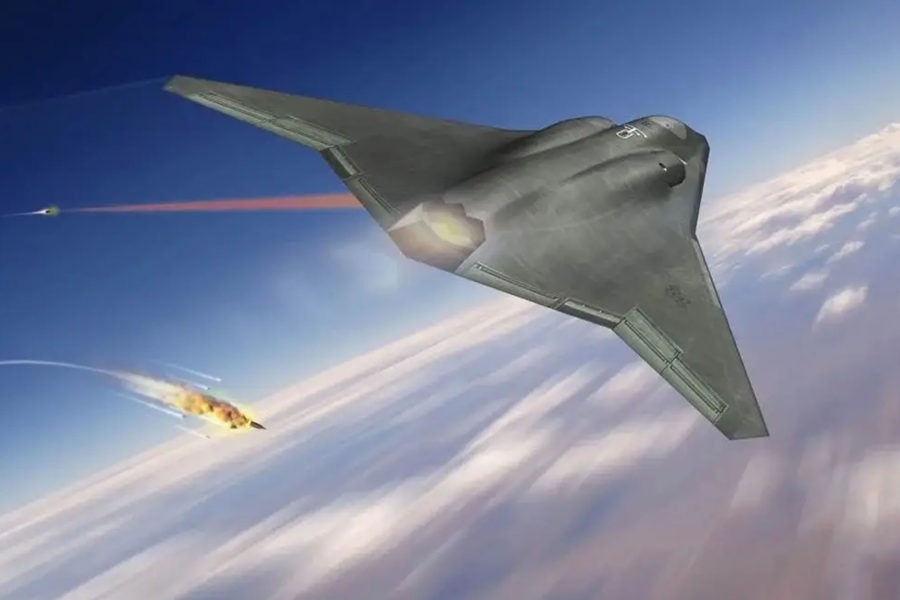In the race to field the first sixth-generation fighter, the U.S. Navy is pressing ahead as the Air Force pauses its program amid concern that it’s too expensive and might not be the best answer to emerging threats. The Navy expects to award a contract for its next-generation, carrier-based fighter and expects the long-range attack jet to enter service in the 2030s, its top officer said Oct. 2.
“We expect that sixth-generation platform to be able to have advanced sensors, advanced lethality, advanced range, and being able to integrate with manned and unmanned capabilities together,” said Chief of Naval Operations Adm. Lisa Franchetti. “That’s one of the things, as we learn from the Air Force and the work they’re doing, to integrate that with what we know that we need to be able to do.”
The Navy will soon decide between competitors Boeing, Lockheed Martin, and Northrop Grumman. “We have three companies that have provided proposals for that and we’re actually in source selection right now,” Franchetti told reporters at a Defense Writers Group event.
Franchetti’s commitment to the program, referred to as F/A-XX for now, comes as the Air Force is reevaluating its future combat jet, the Next Generation Air Dominance (NGAD) aircraft, with a rapid analysis over the course of the next three months.
Air Force leaders have indicated they would prefer a less-costly option. But making NGAD less expensive would likely mean sacrificing range and payload, which could mean opting for a single engine rather than two. Shorter range is also only possible if the Air Force also fields a stealthy Next-Generation Air-refueling System (NGAS), the Air Force’s hoped-for future tanker concept.
The Navy’s F/A-XX is meant to replace its F/A-18 Super Hornet multi-role fighters and E/A-18 Growler electronic warfare attack aircraft. It is planned to deliver greater range and possess more sensing and electronic warfare capabilities than the service’s F-35C fifth-generation fighters.
The Navy is not without budget challenges of its own, however. Earlier this year it delayed roughly $1 billion in investments for F/A-XX to focus on near-term readiness—and Congress may cut the F/A-XX budget even more. But Franchetti’s comments indicate a new crewed fighter is still a Navy priority at the very moment when the outlook for the Air Force’s next-generation fighter appears to be in limbo.
“Air platforms are equally one of the strategic advantages we have” as a service, she said, noting that the other principal advantage is submarines.
Asked if the Air Force pausing NGAD was concerning, Franchetti indicated it is important for the individual services to align their future aircraft plans in some ways, but not so much that the Air Force’s decision—whatever it may be—would be a show-stopper for F/A-XX.
According to the most recent plans, NGAD’s engine was to come from the Next Generation Adaptive Propulsion (NGAP) program. NGAP was to be a more compact application of technologies developed for the Adaptive Engine Transition Program (AETP), which was nixed as an option for the F-35 Lightning II a year ago.
It’s likely that F/A-XX could share engine technology with NGAD.
The Air Force’s NGAD crewed fighter was conceived as a replacement for the F-22 Raptor. Both NGAD and the F/A-XX are intended to operate in concert with uncrewed platforms such as Collaborative Combat Aircraft.
The cost of a crewed NGAD airplane is believed to be between $200 million and $300 million, a major driver behind Secretary of the Air Force Frank Kendall’s decision to pause the program this summer while there might still be time to rethink the program. Asked in September at AFA’s Air, Space & Cyber Conference what price he would consider reasonable, he indicated he’d prefer to pay no more than the price of an F-35—about $80-100 million.
The Air Force must make a decision within the next few months on the future of NGAD to inform the service’s fiscal 2026 budget. Kendall is confident NGAD will go forward in some form, saying in July that “we’re still going to do a sixth-generation, crewed aircraft.”
“I think more broadly, as all the services work together to make sure that they have complementary capability, ‘Where can we learn from each other?'” Franchetti asked. “Where can we leverage that learning so you can be more common in the future?”
